Successful PPC campaigns have two aspects: thorough keyword research and well-planned remarketing ads. While tools like the SEMrush PPC Keyword tool can help you with the former, launching the perfect remarketing strategy can be tough. Which is why, during our latest #SEMrushchat, we invited Michelle Morgan, Director of Client Services at Clix Marketing, to share her insights on improving PPC campaigns through remarketing ads. Michelle, along with our other chat participants, discussed how to remarket ads by focusing on the target audience, plus so much more. Here is what they had to say:
Q1. What are the benefits of setting up retargeting campaigns and using Google Analytics for remarketing?
Remarketing campaigns are an essential staple in all PPC campaigns today. Thanks to the volume of content and the numerous channels available to a potential customer, remarketing campaigns cut through the noise and encourage leads to convert.
At this point, I believe Retargeting should be a staple in all advertising strategies. If done well, there can always be a positive outcome from reengaging with previous visitors. #semrushchat 2/7
— Michelle M (@michellemsem) June 27, 2018
Here are some ways it can help create a positive outcome for your campaigns:
1. Create Top-of-the-Mind Awareness
Most customers don’t buy from a brand the first time they click on an ad. According to Pair Networks - @pairnetworks, an average shopper needs to be introduced to a brand 27 times before making a purchasing decision. This continuous exposure helps you to build trust and credibility with your lead and, in turn, will encourage them to convert.
2. Encourage Users to Take Action
Retargeting campaigns help you reach leads who have already engaged with your brand, but, for some reason have not converted yet. By repeatedly showing your ads, you can nurture them to conversion.
A1: Through retargeting, you're able to easily reach people who have already engaged with your brand in some way.
If they didn't take action and convert before, this could be your chance to secure them. #semrushchat
— Express Writers (@ExpWriters) June 27, 2018
It helps to push users from consideration to Purchase funnel #semrushchat
— Ashish ☬ (@BeingPunjabi_) June 27, 2018
3. Cross-Selling, Pp-Selling, and Re-Selling
Retargeting campaigns are not just for leads who have yet to convert. Existing customers can also be targeted and encouraged to buy more from your brand; this can be ads for an offer of a product they have recently purchased, ads for a product that is complementary to their recent purchase, and so on.
Retargeting campaigns are a great way to reengage with users who have interacted with your company before. Maybe they didn't convert and you're trying to win them over. Maybe they did and you're trying to upsell, cross sell, resell, etc. #semrushchat 1/7
— Michelle M (@michellemsem) June 27, 2018
4. Use Google Analytics to Create Targeted Lists
The effectiveness of your remarketing campaigns is largely dependent on sending targeted messages to your existing customer list; this is where Google analytics can help you.
Google Analytics is a great way to build meaningful Retargeting lists based on the data in your GA profile. Using the Audience builder, you can create nearly any segment of users to leverage in Google AdWords (soon to be Google Ads) campaigns. #semrushchat 3/7
— Michelle M (@michellemsem) June 27, 2018
Using GA, you can get a basic list of the users who engaged with your brand, what their intent is, and what kind of action they took on your site. This information can help you to create segmented lists to send them personalized and custom content that is relevant for their search.
A1: IMO using Google Analytics provides you with a starter pack of remarketing lists like page depth, duration, but you can also create conditional lists and lists based on intent. #semrushchat
— Danny Ray Lima (@dannyraylima) June 27, 2018
A1: Pretty much anything in Analytics can be created into a remarketing audiences. Instead of page visits we can target specific groups of people and the actions they took on the site. #semrushchat
— Joe Martinez (@MilwaukeePPC) June 27, 2018
By linking Google Analytics with Google Adwords, you can leverage the lead insights you get from your website to build segmented lists. Though you cannot use Google Analytics data to enhance your campaigns in other channels, you can still use the audience builder to target users on the Google Search Engine, which can be a substantial win for your PPC campaign.
The biggest drawback with Google Analytics audiences is that they can only be leveraged in Google AdWords and not other channels. Maybe someday we'll be graced with that ability, but I'm not holding my breath. #semrushchat 6/7
— Michelle M (@michellemsem) June 27, 2018
To take advantage of the GA audience builder, you have to link your AdWords and GA accounts. I wrote a post about how to do this and some other benefits of linking these accounts late last year that might be of use to some folks. #semrushchat 7/7
— Michelle M (@michellemsem) June 27, 2018
So, remember to link your Google Analytics account with your Google Adwords to harvest the data you generate. Check out Michelle’s detailed post on the advantages of doing so and the impact it can have on your campaign.
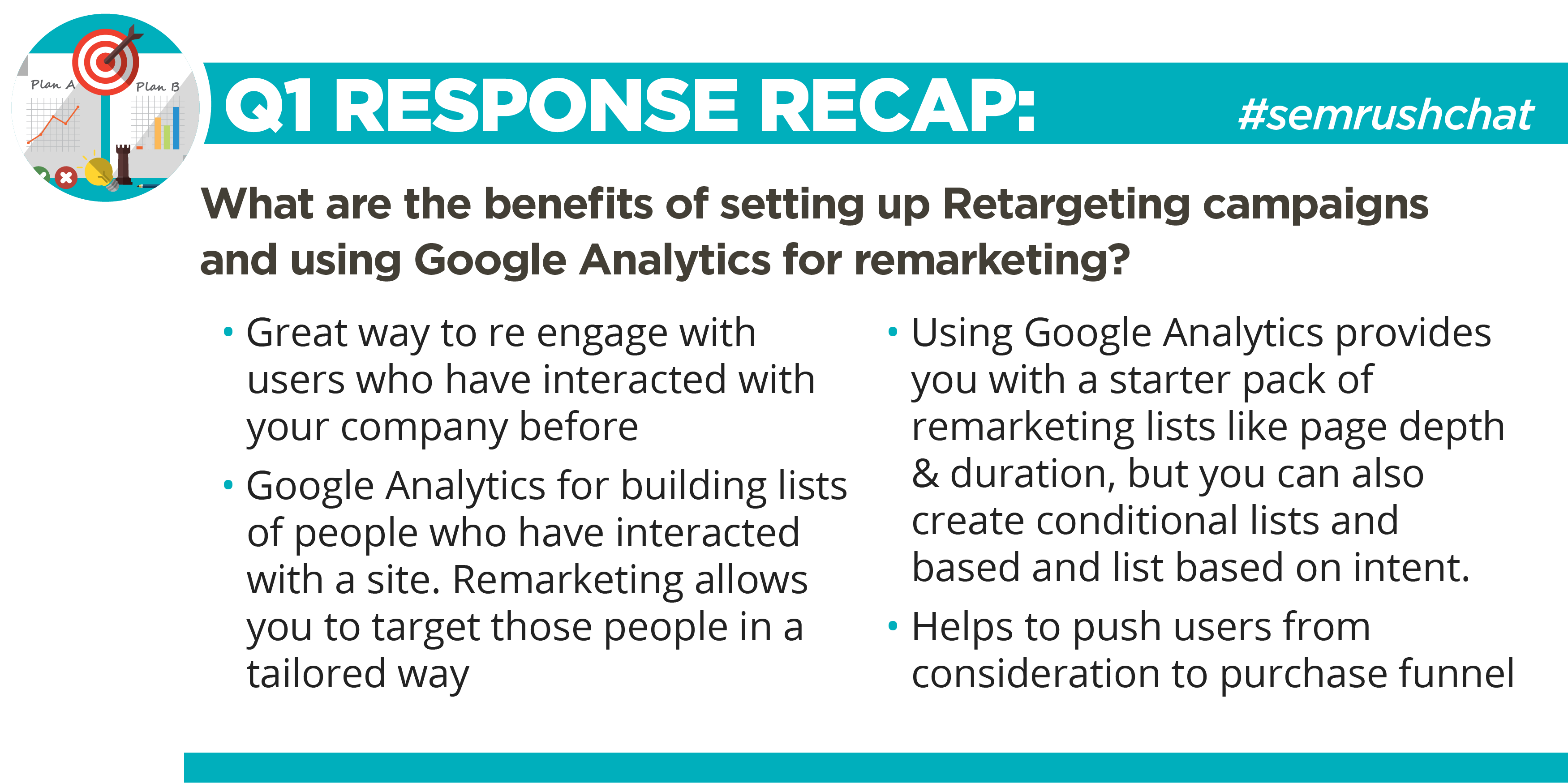
Q2.Is it better to layer RLSA audiences to existing campaigns or create separate campaigns? Why is one better than the other?
Usually, Adwords advises its users to layer RLSA (Remarketing lists for search ads) audiences to existing campaigns and just adjust bids on the campaign level.
A2. @adwords has been advising to layer RLSAs into the same campaigns and just adjust bids on them. #semrushchat
— Reva Minkoff (@revaminkoff) June 27, 2018
Though the decision depends a lot on the industry (and can vary), layering the RLSA audience on existing campaigns can be efficient if the ad message and landing page are going to be the same.
A2. Depending on the industry, I could see the argument to make separate campaigns and write unique remarketing copy for RLSA audiences. #semrushchat
— Reva Minkoff (@revaminkoff) June 27, 2018
A2: If you’re not going to change your ad message and landing pages then you might not need to separate them. But remember budgets are controlled at the campaign level. #semrushchat
— Joe Martinez (@MilwaukeePPC) June 27, 2018
If you are still stuck, here are the two main criteria outlined by our chat participants that can help you make this decision:
1. Volume of the RLSA List
Unless the volume of the list of your RLSA campaign is at least 1000 users, it may not need a separate campaign.
A2: with RLSA your audience needs to be at least 1,000 users. This can easily dictate how you may want to structure campaigns. #semrushchat
— Joe Martinez (@MilwaukeePPC) June 27, 2018
A2 This is a debate that's been going on for awhile that I don't think should actually be a debate. I think there's a pretty simple answer: volume. #semrushchat 1/5
— Michelle M (@michellemsem) June 27, 2018
So, start with layering RLSA audiences into existing search campaigns. These could function as observation lists that can tell you the exact volume of leads those lists are generating. Once the volume is high enough, you can easily break them off to separate campaigns.
A2 Start off by layering RLSA audiences into existing Search campaigns as Observation layers to see how much volume those lists are actually generating. #semrushchat 2/5
— Michelle M (@michellemsem) June 27, 2018
A2 If volume is decent, then it makes sense to break those audiences out into their own set of campaigns. This allows for more optimization since all ad group and campaign level settings will be at your disposal to tweak separately from Search campaigns. #semrushchat 3/5
— Michelle M (@michellemsem) June 27, 2018
A2: I typically start off with layering audiences on to start capturing data, once I have enough data I will start breaking audiences out into separate campaigns to make messaging & budget mgmt easier #SEMRushChat
— Natalie Barreda (@nataliebarreda) June 27, 2018
2. Campaign Level Optimization
Breaking the RLSA audience into a whole new ad group lets you track, adjust, and optimize the settings at the campaign level; this will give you better control of your data, the ad messages, and help make your ads more targeted. You can also create multiple campaigns – one for each list in such a way that the messaging and landing page are consistent, but the user intent is different.
A2: Always set up new RLSA campaigns so you keep that all separate.
The more niched you get with ANY campaigns, the easier it is to track, the better it'll perform, etc. #semrushchat https://t.co/hiSObfMkjf
— ThinkSEM (@ThinkSEM) June 27, 2018
A2: The Best way is to create its own campaign and budget. Depending on list, you can create multiple campaigns with different intent that way the messaging can be consistent across ad copy and LP #semrushchat
— Danny Ray Lima (@dannyraylima) June 27, 2018
If the volume is not high and the ads you are targeting are not niche enough, then you can continue layering them in existing campaigns, since doing otherwise will consume too many resources. In this scenario, you can leverage bid modify layers in Google Adwords to adjust bidding to lists that don’t perform that well.
A2 Our goal is to optimize as much as possible without passing the point of diminishing returns. If there's enough volume, I nearly always break out RLSA into their own campaigns for better optimization. If volume is too low, my time is best used elsewhere. #semrushchat 5/5
— Michelle M (@michellemsem) June 27, 2018
A2 If you don't see much volume from these lists, it's probably best to keep them as layers in existing campaigns, but then leverage bid modifier layers to bid up or down based on that list's performance. #semrushchat 4/5
— Michelle M (@michellemsem) June 27, 2018
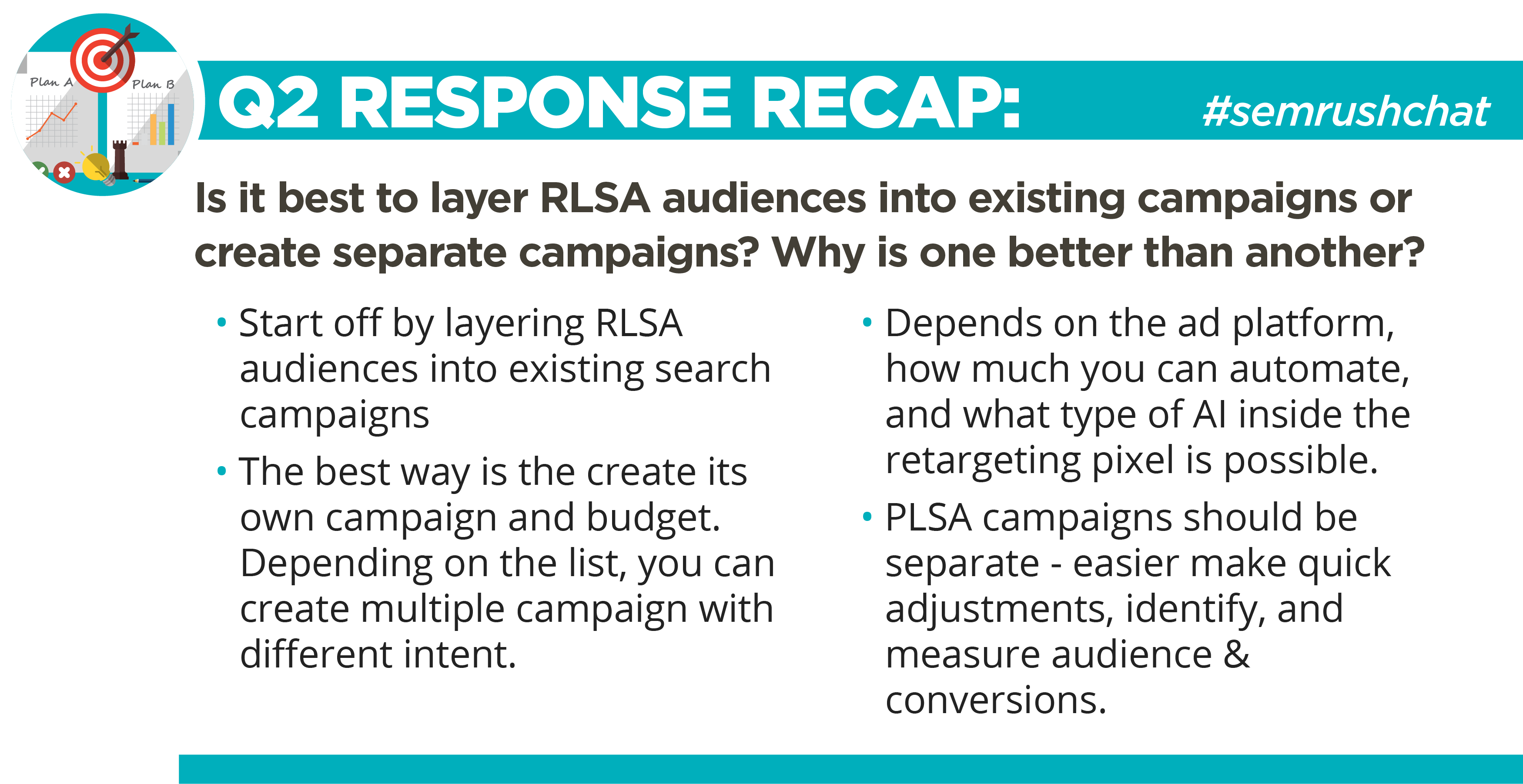
Q3. In your opinion, what is the biggest technical challenge when it comes to re-targeting? Is it more about the quality of data, the underlying algorithm or something else?
Technical challenges, for our chat audience, have been somewhat few and far between. The algorithms and data have not proved to be as much of a challenge as Privacy has, which is the latest obstacle digital marketers are facing today.
A3 I can't say that I've had major "technical" issues with Retargeting. I've found data quality and algorithms to be fine. I think the bigger issue we're going to face moving forward is privacy. #semrushchat 1/5
— Michelle M (@michellemsem) June 27, 2018
A3 Unfortunately, we also don't know all the implications of these new regulations, and it doesn't help that the EU is going to have different rules than other countries for awhile. #semrushchat 3/5
— Michelle M (@michellemsem) June 27, 2018
Because of the latest GDPR compliance issues and EU regulations, here are some practical problems that can hinder your retargeting campaigns:
List Size
Since a lot of accounts these days require opt-in cookies, it can be hard to populate a retargeting list.
A3 With GDPR and other news, we're already running into issues with accounts that require opt-in cookies, making it hard to populate a Retargeting list. I think this problem is only going to get more prominent as time goes on. #semrushchat 2/5
— Michelle M (@michellemsem) June 27, 2018
A3: With basic Google/GA remarketing I've never really had huge technical issues (other than the sadness of lists not populating the way I hoped they would). However, when you start integrating 3rd party data partners (Adobe Audience Manager, Blue Kai, etc.) 1/2 #SEMRushChat
— Natalie Barreda (@nataliebarreda) June 27, 2018
If there are not enough cookie-fires, then there simply will not be a sufficient audience in each list to meet the required channel minimum. With a small list size, it becomes impossible to micro-target the leads and send them customized content.
A3 For the coming months, I think our biggest issue will be generating enough cookie fires to create large enough Retargeting lists to meet channel minimums. As advertisers, we might not be able to segment our audiences as granularly as we have in the past. #semrushchat 4/5
— Michelle M (@michellemsem) June 27, 2018
Balancing Frequency and Effectiveness
While it is not necessarily a technical aspect, identifying how frequently to show your ads to bring about conversions (or encourage lead to take action) can be tricky. But, knowing how frequently to show the ad to encourage conversion and still not overspend can make a tremendous change in your ad campaigns.
A3: Finding the right balance of frequency and effectiveness. If you’re capping your remarketing ads at only a couple views, you’re not doing it right. People need several touch points. #semrushchat
— Joe Martinez (@MilwaukeePPC) June 27, 2018
A3: Answering this question from the perspective purely of a generalist, the biggest technical challenge is knowing when to use remarketing and how much to spend on it. #bafflingforgeneralists #semrushchat https://t.co/GPzBpEJ8Qh
— Anita Campbell (@smallbiztrends) June 27, 2018
Meaningful Retargeting
Another challenge is knowing when to retarget the audience. Merely showing ads to leads who have visited just the homepage of your site will drain your resources. The ads have to be more targeted and personalized, which would entail the correct retargeting strategy.
In the coming months, the retargeting strategy used will have to be more flexible and agile, to accommodate the changing regulations pertaining to privacy policies.
A3 We'll need to stay flexible and adjust Retargeting strategies based on these limitations to be able to stay on the right side of the regulations. It's not going to be fun, but it will be necessary. #semrushchat 5/5
— Michelle M (@michellemsem) June 27, 2018
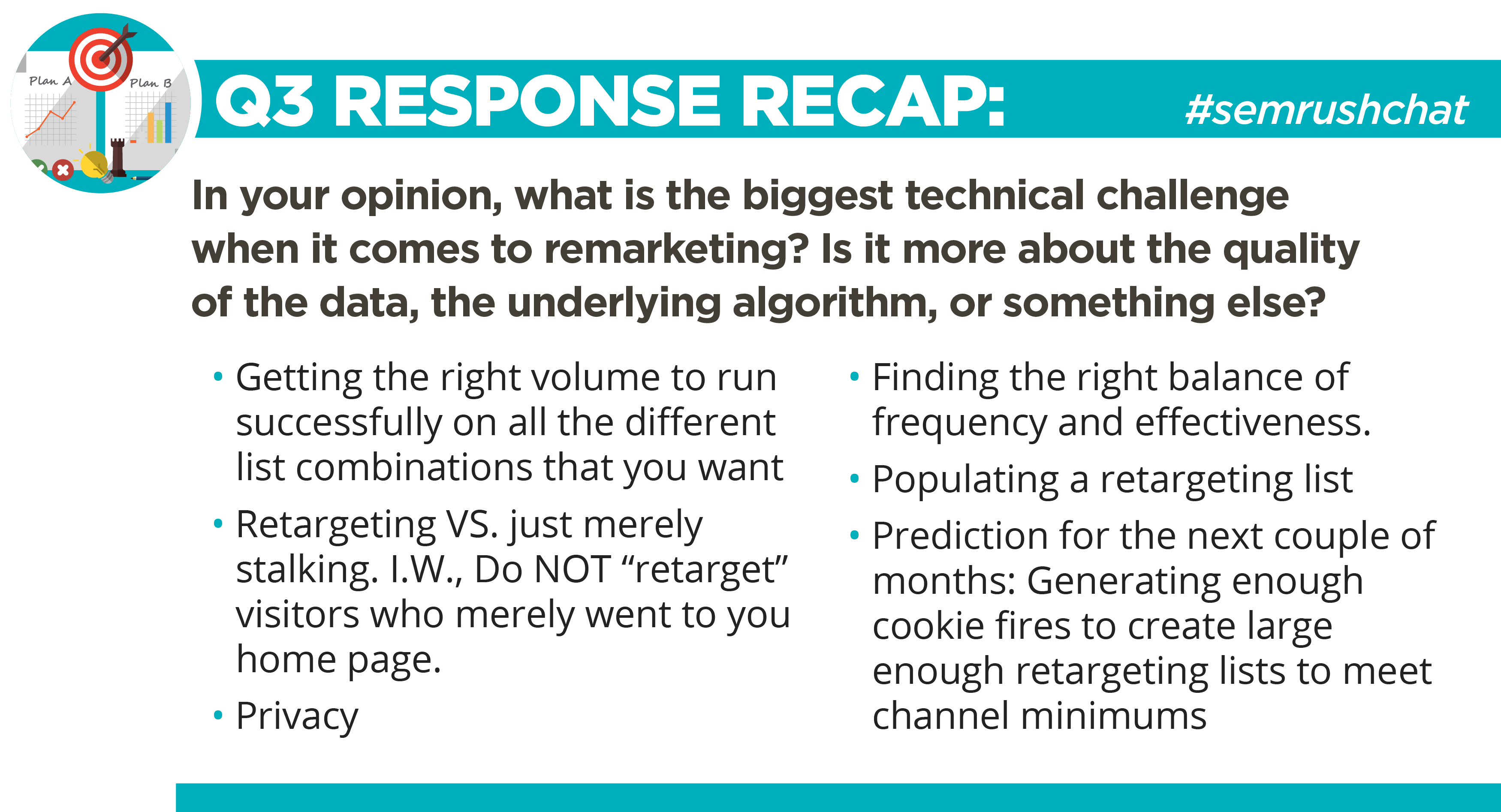
Q4. In your opinion, how long is “too long” to run a remarketing campaign to the same audience? Why?
Determining the exact time in which an ad can be served is crucial for brand image. A frustrated or bored audience, who may feel stalked all over the internet, will not think very positively about your business. There exists a specific time-gap for each business and going beyond it will definitely not win your audience’s favor.
A4 There must be a sweet spot for each industry and audience segment - I'd say a day after that is the time to stop else you will start to damage brand. #semrushchat
— Simon Cox (@simoncox) June 27, 2018
Unfortunately, there is no specific timeline on how long a set of audiences can be marketed to. There is definitely no “one size fits all” marketing strategy when it comes to this.It largely depends upon your sales cycle, the general industry standards, and of course the interest and the engagement level of your audience.
A4) It depends on the length of the sales cycle, amongst other things. Determining the length of time to make the offer is difficult, at best.
Guesswork, informed choice, analytics data and tea leaves are all great ways forward. #semrushchat
— David Rosam (@davidrosam) June 27, 2018
Totally agreed. This answer will be different for every business. Definitely needs to be something each advertiser figures out for their own campaigns based on unique sales cycles. #semrushchat
— Michelle M (@michellemsem) June 27, 2018
In fact, a stale ad or an ad that has run too long is not determined by the time it has run, but rather by the message it carries. If the offer has not changed over a period of time, then it is too long.
A4 I've spoken about this recently and I think it's a continuing problem we see with Retargeting use. There's not necessarily a set timeline on how long you can retarget to a single audience. The problem stems from not changing your offer over that time frame. #semrushchat 1/9
— Michelle M (@michellemsem) June 27, 2018
One way to identify stale messaging is by checking how well the offer is converting during a specific time frame. Instead of blindly accepting the default timeline in cookie settings (i.e., 180 days on Facebook), you can break it up to serve different offers and see which one is converting better. Based on the most recent data, you can decide which offer performs best; this can help you re-engage users and create custom content that your audience may find more engaging, and boost conversions.
A4 Imagine you click on an ad for a whitepaper, you then read the landing page and realize that whitepaper isn't what you wanted. So you leave. #semrushchat 2/9
— Michelle M (@michellemsem) June 27, 2018
A4 Most advertisers will continue to push that same whitepaper for the length of time you're in that audience. Usually, that's the longest time frame the cookie can exist because we default to the longest time frame. (180 days on FB, 540 on AdWords, etc.) #semrushchat 3/9
— Michelle M (@michellemsem) June 27, 2018
A4 What we advertisers should do instead is break up those cookie lengths and offer different whitepapers (or ebooks or some other call to action) as time goes on to reenage users with content that might be more appealing. #semrushchat 4/9
— Michelle M (@michellemsem) June 27, 2018
A4 The idea is to take recency into account and change things up as time goes on. Maybe in the first 7 days you offer the same whitepaper, but then offer something else for the next 7 days if the person didn't convert on the original whitepaper. #semrushchat 5/9
— Michelle M (@michellemsem) June 27, 2018
A4 This will give you a better chance of a conversion and the user won't feel your offer is stale or that you're hounding them all around the web. #semrushchat 6/9
— Michelle M (@michellemsem) June 27, 2018
If you are going by the sales cycle, you need to ensure that the retargeting timeline is in accordance with it.
A4: Somewhat trick question: it depends on the **normal** conversion cycle for your audience. If it's a quick turn-around, don't follow them around with retargeting ads for 6 months. But, vice versa, if it's a long close cycle, then 6 months might be perfect. #semrushchat https://t.co/Lrwi8zywgD
— ThinkSEM (@ThinkSEM) June 27, 2018
However, bear in mind that despite the amount of retargeting and customization of messages, not all audiences will convert. Knowing when to stop serving ads to leads who haven’t converted is also essential. Otherwise, it would again be a case of retargeting for too long; this is where the Time Lapse report on Google Analytics can help, it will give you an idea of how long after the first visit a lead is likely to convert, and you can then serve your ads within that timeline.
A4 At a certain point, however, we have to let that person go. The Time Lag report in GA can help you determine how long after the first visit someone is likely to convert. Use this report as a guideline for your cookie lengths. #semrushchat 8/9
— Michelle M (@michellemsem) June 27, 2018
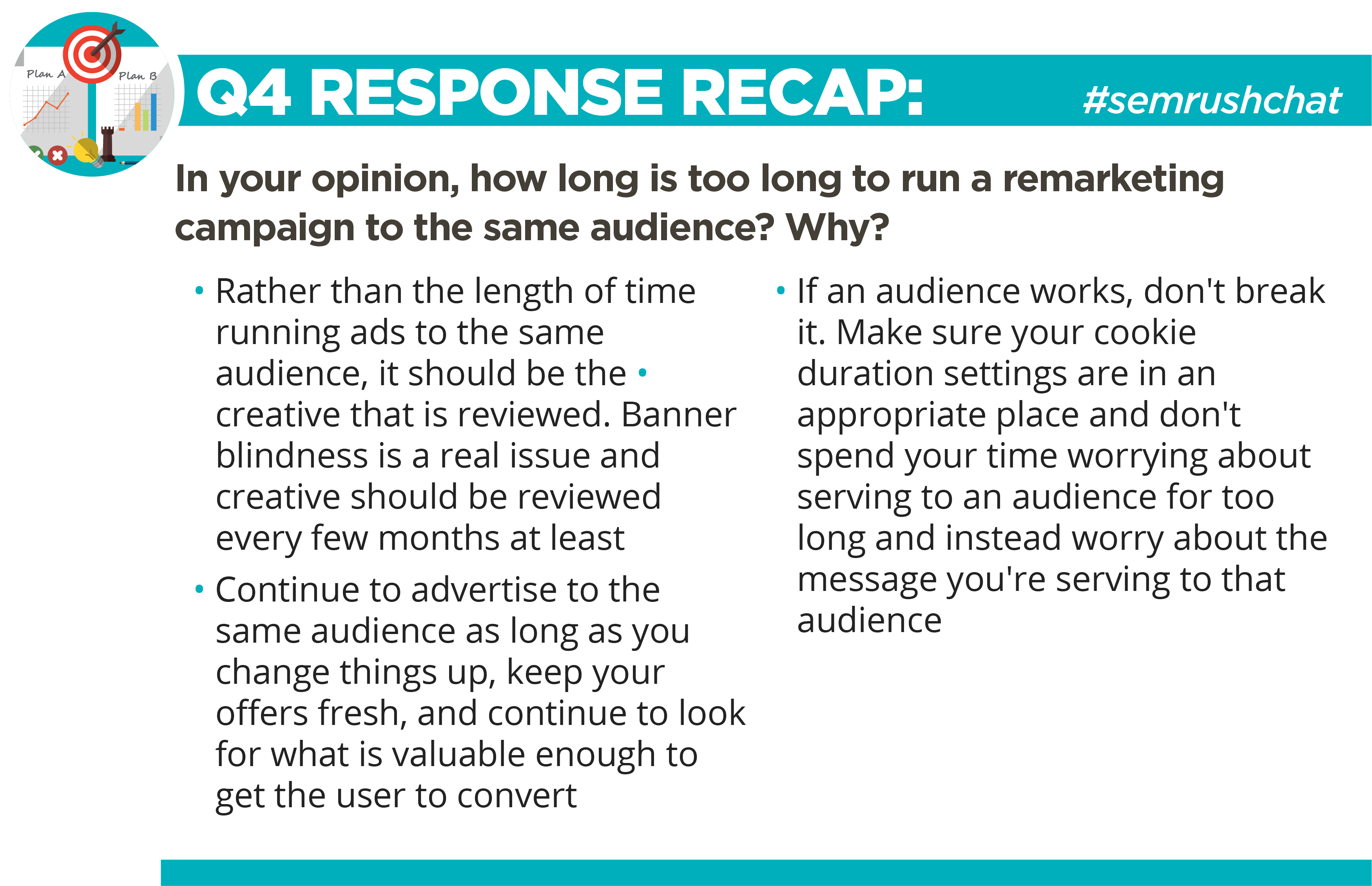
Ultimately, if an audience works, do not change it. Instead, alter cookie duration settings, the messaging, and the offer to keep it fresh. Remember that content, especially visual, can become old pretty fast thanks to Facebook, Instagram, and Google Display Network. To combat banner blindness, continuously change and tweak the content to provide the user with enough value that helps them to convert.
A4 Overall, you can continue to advertise to the same audience for a very long period of time as long as you change things up, keep your offers fresh, and continue to look for what is valuable enough to get the user to convert. #semrushchat 9/9
— Michelle M (@michellemsem) June 27, 2018
A4: If an audience works, don't break it. Make sure your cookie duration settings are in an appropriate place and don't spend your time worrying about serving to an audience for too long and instead worry about the message you're serving to that audience. 1/2 #semrushchat
— Natalie Barreda (@nataliebarreda) June 27, 2018
Q5. What are the best ways that a startup can use ad remarketing for audience build up?
For start-ups, the initial challenge is bringing about awareness of their brand and then conversions through retargeting. If there are not enough people visiting their site, there may not be enough of an audience to remarket to. In such cases, investing in Display and YouTube ads to drive awareness would be a good first step.
A5: Startups need to ask first if people even know about them. Can’t remarket in AdWords without site traffic. If people don’t know you exist you’ll have to invest in display and YouTube first to drive awareness and traffic #semrushchat
— Joe Martinez (@MilwaukeePPC) June 27, 2018
A5 Startups can greatly benefit from using Retargeting since they're usually introducing us to something entirely new that we've not seen before. Usually, this will take multiple touches to get the point across, so audience building can be very important. #semrushchat 1/7
— Michelle M (@michellemsem) June 27, 2018
Facebook remarketing can be a powerful tool as well. Startups can set up a non-branded campaign for all past visitors in remarketing and then go about building the list.
A5: best way is to set up a list for all past visitors in remarketing and set up a non-branded campaign to run. In this instance, I would also use Facebook remarketing, this can be a powerful tool for a startup #semrushchat
— Danny Ray Lima (@dannyraylima) June 27, 2018
However, a major problem that start-ups struggle with is determining their target audience persona. The new product or service line that they are establishing can cater to a multitude of different audiences,which can be understood better from machine learning or artificial intelligence.
You don't always know who your best target audience is, in the case of a startup or new product line! Machine algorithms (using AI and machine learning) may know a lot better and you could be surprised. #semrushchat https://t.co/bMPplZyOS9
— Anita Campbell (@smallbiztrends) June 27, 2018
Another way to determine the target audience is by exploring as many new mediums as possible. Engagement campaigns on social media and video ads on YouTube can all provide valuable data about the audiences, which you then can use to build remarketing lists.
A5 It's a given to retarget your website visitors, but many startups are leveraging "new" mediums & running videos ads on YouTube or engagement campaigns on social profiles. Don't forget that these channels have Engagement audiences available as well. #semrushchat 2/7
— Michelle M (@michellemsem) June 27, 2018
Use pre-set audience filters across channels like Facebook, Youtube, and Instagram to see which types of users engage most with your brand and your message. Not only can you run retargeting ads for these lists, but you can also use it to identify new audience group via the ‘look-alike’ and ‘similar audience’ feature across other channels.
A5 Facebook has a whole section of preset audience filters based on users engaging with your Facebook and Instagram posts, profiles, videos, etc. YouTube has the same thing for videos and company profiles. Other platforms have similar solutions as well. #semrushchat 3/7
— Michelle M (@michellemsem) June 27, 2018
A5 Additionally, nearly all major advertising platforms have the ability to create Lookalike or Similar Audiences based on Retargeting lists. This means a smart Retargeting list set up can also help you reach new users similar to those Retargeting lists. #semrushchat 5/7
— Michelle M (@michellemsem) June 27, 2018
The secret in earning better ROI with retargeting ads is not just engaging with the same audience (even though it is important), it is about reaching new audiences with the data you already have from running campaigns from other channels. By marketing to these leads, you can increase your audience list, improve your reach, and boost conversions.
A5 For a startup, this can be highly valuable as it's not always clear who the exact target audience will be. Sometimes you might be surprised who the algorithms think are a good fit for you based on how they engage with the platforms. #semrushchat 7/7
— Michelle M (@michellemsem) June 27, 2018
A5 Retargeting isn't just about engagement with the same audiences anymore; it's now a way to build a better outreach model using each channel's available algorithms and data. #semrushchat 6/7
— Michelle M (@michellemsem) June 27, 2018
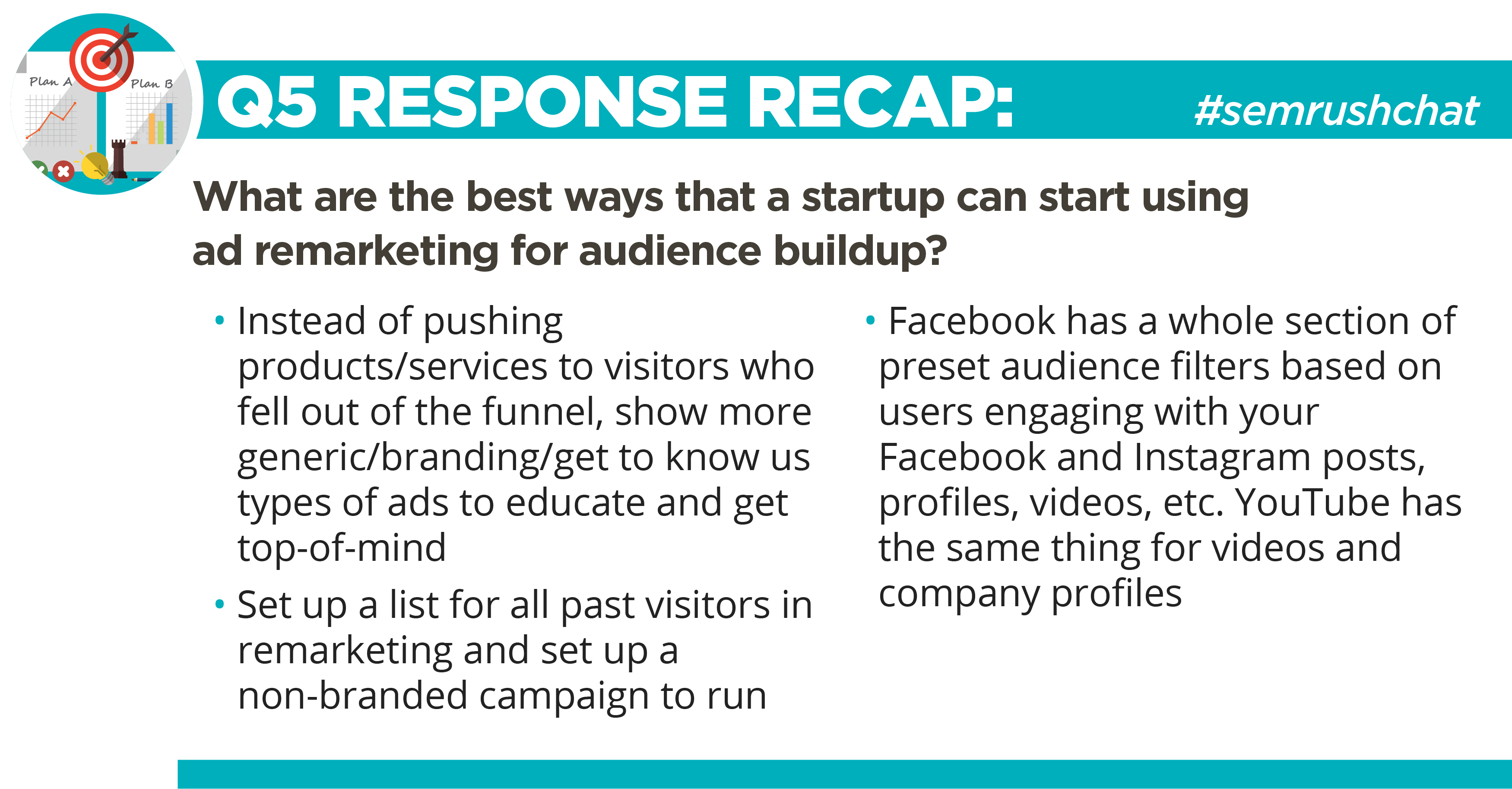
That’s all for today! Have you faced these same issues while using remarketing campaigns for your business? Let us know in the comments!
We will not be having an #SEMrushchat on July 4 because of the US holiday, make sure to join us again on July 11 where we will be doing a Live Site Audit!
Innovative SEO services
SEO is a patience game; no secret there. We`ll work with you to develop a Search strategy focused on producing increased traffic rankings in as early as 3-months.
A proven Allinclusive. SEO services for measuring, executing, and optimizing for Search Engine success. We say what we do and do what we say.
Our company as Semrush Agency Partner has designed a search engine optimization service that is both ethical and result-driven. We use the latest tools, strategies, and trends to help you move up in the search engines for the right keywords to get noticed by the right audience.
Today, you can schedule a Discovery call with us about your company needs.
Source:





